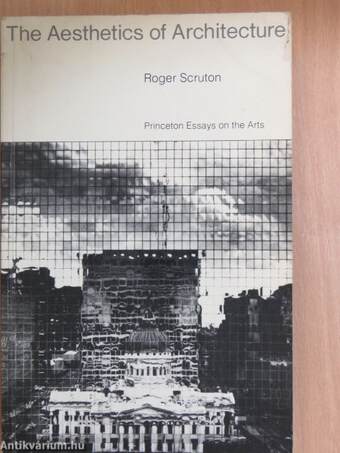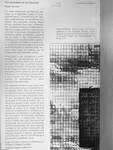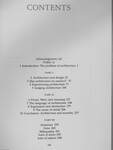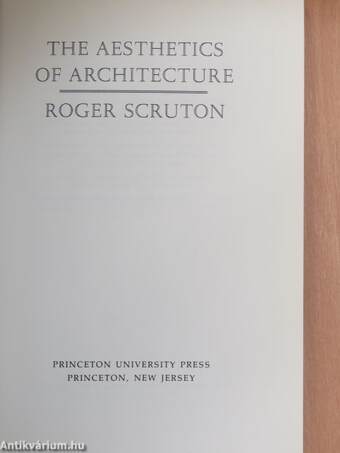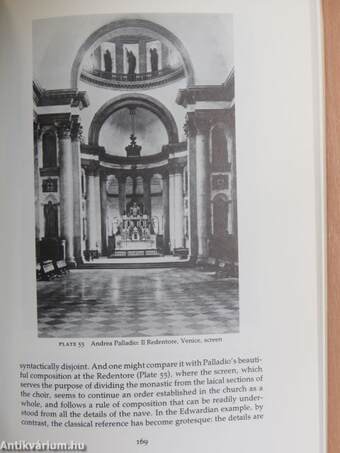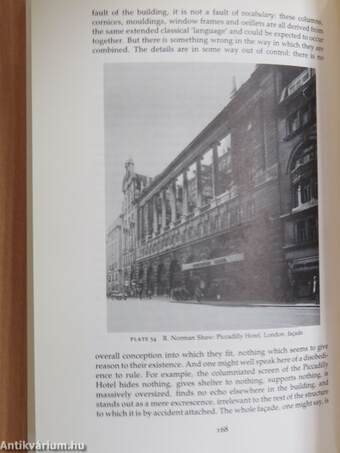1.062.236
kiadvánnyal nyújtjuk Magyarország legnagyobb antikvár könyv-kínálatát

VISSZA
A TETEJÉRE
JAVASLATOKÉszre-
vételek
The Aesthetics of Architecture
| Kiadó: | Princeton University Press |
|---|---|
| Kiadás helye: | Princeton |
| Kiadás éve: | |
| Kötés típusa: | Ragasztott papírkötés |
| Oldalszám: | 302 oldal |
| Sorozatcím: | Princeton Essays on the Arts |
| Kötetszám: | 8 |
| Nyelv: | Angol |
| Méret: | 23 cm x 15 cm |
| ISBN: | 0-691-00322-x |
| Megjegyzés: | Fekete-fehér fotókkal. |
naponta értesítjük a beérkező friss
kiadványokról
naponta értesítjük a beérkező friss
kiadványokról
Fülszöveg
The Aesthetics of Architecture
Roger Scruton
$7.95 in U.S. orily
Aesthetics/Architecture
This book establishes architectural aesthetics as a legitimate subject of philo-sophical inquiry. Characterizing the "aes-thetic understanding" of architecture as a rational and conscious activity, Roger Scruton maintains that much contempo-rary architectural theory mistakes the natúré of its subject and that a return to first principles is necessary. Consequently, he develops a theory of aesthetic judgment and its place in the understanding of buildings and in practical matters general-ly. In applying this theory to architecture, he argues for both the objectivity and the morál significance of aesthetic taste. As a result many ways of building can be shown to be right and others wrong.
In the author's view, architecture is distin-guished from representational arts such as painting, drama, poetry. and sculpture, and even from music, by certain features: its sense of function, its... Tovább
Fülszöveg
The Aesthetics of Architecture
Roger Scruton
$7.95 in U.S. orily
Aesthetics/Architecture
This book establishes architectural aesthetics as a legitimate subject of philo-sophical inquiry. Characterizing the "aes-thetic understanding" of architecture as a rational and conscious activity, Roger Scruton maintains that much contempo-rary architectural theory mistakes the natúré of its subject and that a return to first principles is necessary. Consequently, he develops a theory of aesthetic judgment and its place in the understanding of buildings and in practical matters general-ly. In applying this theory to architecture, he argues for both the objectivity and the morál significance of aesthetic taste. As a result many ways of building can be shown to be right and others wrong.
In the author's view, architecture is distin-guished from representational arts such as painting, drama, poetry. and sculpture, and even from music, by certain features: its sense of function, its localized quality, its technique. its public and non-personal character, and its continuity with the dec-orative arts. It is primarily a vernacular art in that it exists first and foremost as a process of arrangement in which everyone may participate.
But. because architects must fit their work into somé pre-existing arrangement of un-changeable forms. they are constrained by influences and circumstances that for-bid the luxury of a self-consciously "artis-tic" aim. Architecture. then, is simply one application of that sense of what "fits" —a sense that governs every aspect of daily life, be it an arrangement of a room or a manner of dress. Thus, Roger Scruton contends, an aesthetics of architecture is, at the least. an aesthetics of everyday life. For this reason, he concludes, aesthetic understanding is insepar?ble from a sense of detail and style. from which the appropriate, the expressive, the beautiful, and the proportionate iake their meaning. Included in the author's discussion are critiques of the romantic, functionalist, and rationalist theories of design, and attacks on the Freudian, Marxist, and semiological approaches to aesthetic value.
Roger Scruton is Lecturer in Philosophy at Birkbeck College in London. Princeton Essays on the Arts, 8
Cover lllustration: Old St. Louis Court House reflected in The Equitable Building Photo: Seagram County Court House Archives, Library of Congress. Detail from the photograph by William Clift. Vissza
Témakörök
- Idegennyelv > Idegennyelvű könyvek > Angol > Művészetek > Építészet
- Idegennyelv > Idegennyelvű könyvek > Angol > Művészetek > Művészettörténet, általános
- Művészetek > Művészettörténet általános > Esztétika
- Művészetek > Művészettörténet általános > Idegen nyelv > Angol
- Művészetek > Építészet > Tanulmányok, esszék
- Művészetek > Építészet > Idegen nyelv > Angol
Roger Scruton
Roger Scruton műveinek az Antikvarium.hu-n kapható vagy előjegyezhető listáját itt tekintheti meg: Roger Scruton könyvek, művekMegvásárolható példányok
Nincs megvásárolható példány
A könyv összes megrendelhető példánya elfogyott. Ha kívánja, előjegyezheti a könyvet, és amint a könyv egy újabb példánya elérhető lesz, értesítjük.



